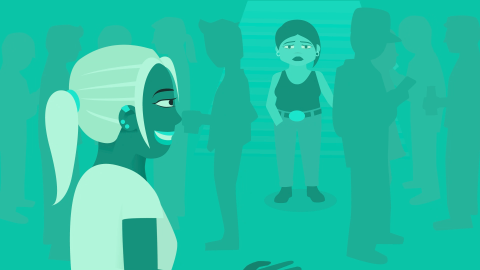
Help stop it
Many of us have seen some form of abusive and harmful behaviour against women and girls, but it can be difficult to know whether to intervene. Some people worry they’ve maybe misread the situation and could make things worse. Some worry about putting themselves at risk. If you’re unsure about whether to intervene, here are some key signs to look out for.
- Does the person look uncomfortable or upset?
- Are they trying to escape or move away?
- Do they seem frightened?
- When you make eye contact, do they respond in a way that makes you think they want help?
How to step in safely
Intervening doesn’t have to be dramatic or confrontational. Even small acts of recognition and support can help stop abuse. Here are four simple ways to help you step in safely – just think STOP.
-
You can show your disapproval at what is going on for example, by not laughing and saying, 'I don’t think that’s funny'. Or you could be more direct, if you feel it’s safe to do so, by saying it’s unacceptable and tell them to stop.
-
You could tell someone in charge, like the bar staff if you’re in a pub or club, Human Resources (HR) if you’re at work, or the train guard or bus driver if you’re on public transport. You could also tell another member of the public or a passer-by and see if they’re willing to help – working together can be a safer, more effective way to intervene. It is important to check in with the victim on who they want to tell, or if they want to call the police.
-
You can ask the victim if they’re OK. You could capture what’s happening on your phone and ask if they want the footage to report the incident, and you could offer to help report it. You could also help others already giving support. If it’s someone you know, check in with them when they are alone and offer to help or support them to report it if they want. If you think they might be in an abusive relationship, there is expert advice on what you can do and support available online or on the National Domestic Abuse Helpline.
-
Sometimes what's best in the moment is creating a distraction, giving the person being targeted a chance to move away or giving others the opportunity to get help. You could strike up conversation with the victim, e.g. ask for directions, or where the next stop is on the bus, or pretend you know them. If you’re at work, you could make up an excuse to speak to them about an unrelated task. You could also try dropping something nearby or creating some other minor commotion.
If you think somebody is in immediate danger, call 999.
Test yourself: how could you help?
Explore the scenarios below to see how you could put these ways to intervene safely into practice.

Controlling or coercive behaviour.
You think your friend is being controlled by her new boyfriend…

Intimate image abuse
Your friend is sharing nudes of his ex in a group chat.

Unwanted touching
You see a woman being groped in a club.

Unwanted sexual comments
You see someone making unwanted sexual comments to a woman on the bus.
Have these scenarios made you think?
If you can think of a situation when your behaviour - whether deliberate or not - has upset, embarrassed, hurt, controlled or coerced someone, be honest with yourself. It’s the first step to making a change for the better.
